 |
|
Stevie Salas |
Go back in time and catch Bill and Ted’s Excellent Adventure then guess who played those fiery guitar riffs flying off the fingers of George Carlin’s character, Rufus. If you answered, “Stevie Salas,” then a big, “No way, yes way!” to you.
Considered by many to be one of the top fifty guitarists of all time, Salas has gained the attention of musicians around the world as well as classic rockers like Mick Jagger, George Clinton, Billy Gibbons, Zakk Wylde, Billy Idol, Rick Neilson, and Rod Stewart.
A self-taught Native-American (Mescalero Apache) guitar prodigy and creator of his own rock genre, Salas’ aggressive dark punk-funk style reflects the journey he’s taken from the streets of San Diego to concert arenas. It was a hard stretch of road, but his career took off when funkadelic master George Clinton asked if he’d sit in as his studio guitarist.
The Clinton connection helped pave the way to a recording offer from Island Records – the most attractive in the company’s history. Salas soon became an item in the music world and was embraced by fellow musicians Bootsy Collins, Was (Not Was), and Eddie Money. It wasn’t long before young Stevie was flying around the world in the private jet of classic rocker Rod Stewart.
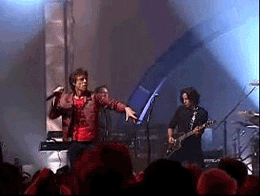 |
|
Stevie Salas (right) with Mick Jagger |
Then, Mick Jagger rang him up for another unbelievable romp in stardom.
Stevie’s first solo outing, Stevie Salas: Colorcode (1990) shows heavy classic rock influences with is heavily influenced by a broad spectrum of early rockers. His second CD, Back from the Living (1994), outran big guns like the Stones and Aerosmith on the Japanese music charts.
Today, Salas music resumé lists 18 solo albums and his contributions to a series of compilation works as a guest artist. Guitar International caught up with singer-songwriter-producer Stevie Salas after he landed from a bit of surfing in Costa Rica and laying down some new tracks for his next CD that he tells us will be called, Stevie Salas: What It Was to Be, What It Is.
Tell us the circumstances when you first realized that music was more than a passion. Where you realized it was going to be a career.
Stevie Salas: When I was fifteen and in high school in Oceanside, California, I had no idea what I was gonna do with my life. I was thinking about the Coast Guard. I loved the ocean. But, I got a guitar that my brother-in-law made and it just fell into place. I played my first party that summer and started playing high school dances and clubs. That was the first step. Then, after high school the hardest thing to do was to realize that my super popular local band had no future.
I had to look at it realistically and leave the comforts of home for Los Angeles, where I went from somebody to nobody. In LA, I had no choice but to focus and make it. Thank God I got lucky!
What artists did you listen to growing up that influenced you to play guitar and develop your own style?
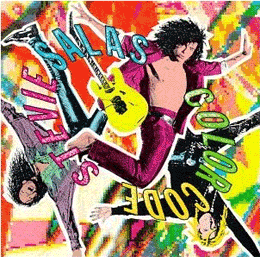 |
|
Stevie Salas: Colorcode |
SS: It’s funny because I grew up in a mixed cultural area in San Diego due to the military. So we hung out listening to Led Zep, Kiss, Ted Nugent, Aerosmith, Judas Priest, the Ohio Players, Van Halen, Bowie and then the Ramones and the Police.
But I also played sports in high school and the black kids would say, “Hey, check out George Clinton, he’s like the Kiss of Funk music!” I never dreamed that in a few years I would be recording with George and hanging out with
Jimmy Page and Paul Stanley and opening for Aerosmith! I ripped all those guys off!
When I got back to L.A. I knew that I would never be as good as Eddie and I loved rock, but I aslo loved funk, like Earth, Wind and Fire. By the way, Eddie is the funkiest brother out there! So, I decided to find some middle ground and fill a void by mixing rhythms and a heavy sound.
Growing up I never cared about guitar players unless they were from a band with great songs. I like bands that use the song as a vehicle for the guitar to stand out.
What gear do you currently use on stage? In the studio?
SS: I have so much stuff in the studio. I always use a ’65 Fender Deluxe Reverb and some old Marshalls. But I also use a Cornford, Ashdown, Boogie cabs, Yorkvilles Sound cabs and for guitars I’ll use anything for a tone, from a ten dollar garage toy guitar to a $100,000 Les Paul.
I think I’ve around sixty to eighty guitars now, includng Gibson, Fender, Music Man, Aparision, Washburn, Cort, James Trussart and tons of others. I think that the tone comes from the hands, but unique guitars and amps help bring it.
How did you end up working with Mick Jagger and Rod Stewart?
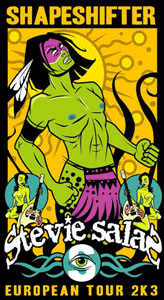 |
|
Shapeshifter tour poster |
SS: When I got to L.A. in 1985, I was starving. I started going out at night and I got into the scene. After that, there was a buzz about me in the city as a “cool guitar player” and producer. It’s funny, in those days Tom Morello and I would play on opposite weeks at clubs and it seemed like there were always photos of me or him in the local magazines. I think because we weren’t metal, but we were part of a new sound. His band Lock Up and mine, Colorcode, both got signed to majors.
So, in 1987 I got a call one day to audition for Thomas Dolby and Andy Taylor. And to my surprise, I got both gigs! I loved Thomas, but he was going play clubs, so I took the gig with Andy because he was gonna play the L.A. Forum. I wanted to play arenas! But, Andy fired me a week before the tour started. It was okay, because his manager was Rod Stewart’s manager and he got me an audition with Rod. Instead of opening for the Psychedelic Furs at the Forum, I headlined three nights at the Forum with Rod!
So, remember what looks like a bad thing might be for the best in the end.
For Mick Jagger, it came at a time I needed something bad. My girlfriend had just died and the gods helped me out! I was at my neighbor and best pal Richie Kotzen’s house when I got a call that Jagger was looking for me. I went and jammed with him. We’d met before, but I knew Keith better and Woody who played on my Nickelbag CD. A week later I got a call.
“Stevie, Mick Jagger here.”
I thought it was Jimmy Dunlop taking the piss out of me, so I almost hung up the phone. I asked how he got my number and why he called.
He just said, in a very posh British voice, “I got your number from Rod Stewart.”
He was kidding, of course.
Tell us about the changes you and your guitar playing have gone through from your first professional gig in L.A. to being considered one of the top fifty guitar players in the world.
SS: That top fifty thing kills me! Thank God for press! I know guys who I watched play in San Diego, when I was a kid, like Luke Albano, Steve Burt, Jake E. Lee, Paul Slagle, and Mike Hakes. These guys could destroy me and all my famous guitar player friends to this day. They just didn’t get the breaks that I did. I will say this. When I got to L.A. I was forced to get better in 1990. When I put out my first Colorcode CD I had to open for Joe Satriani’s Flying in a Blue Dream tour! Man, I was so scared every night on that stage!
If I played at ninety-nine percent I would get blown out, so I had to have my game tight and it made me a better guitar player. I look at guitar playing like I do at sports – you need focus and work hard to win. I focus my thoughts and visualize more than play scales. You gotta be in it to win it!
Your new albums have taken on a real rap/punk/hip-hop aspect to them, what you call aggressive, dark, punk-funk. What influenced this?
SS: Well, I love funk and I started on hip hop in the late ’80s, producing bands like the West Coast Posse. I have recorded with P-Funk, Bootsy Collins, Public Enemy and Was (Not Was). It’s part of me.
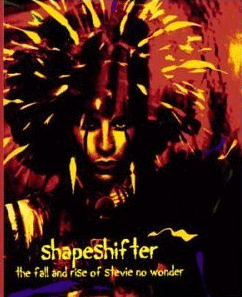 |
|
Shapeshifter |
I understand you took off a year to work on some Native American music. How did that come about and tell us about the tour.
SS: The late, great, Randy Castillo from Ozzy asked me to work on a project with some Indian friends. At the time I had just done two years straight of back-to-back world tours. I was so consumed with which Playboy bunny or actress I could shag and who I was hanging out with. I was becoming a cartoon character. So, I was searching to find myself spiritually and I thought that getting into my native roots would be the answer. So, I played around for a year doing benefits and political events until I was almost broke.
I then realized there was as much corruption in the political world as in my rock world, except instead of making ten grand a week I was broke!
So, it made me realize that I could find a middle ground and still be a rock star without being ashamed of myself.
What qualities do you look for in a new guitar?
SS:You know, I’m on a search now. My two favorite guitars were stolen in 1997 and I haven’t found the right fit yet. It’s tough for me since I need a guitar that can be clean and funky and get dirty and heavy. I like a set-neck, Gibson scale, mahogany body, maple top, rosewood fretboard with low output pickups.
Tell us about the collaborative process you went through with Washburn guitars and the Washburn MG130 Stevie Salas Signature Model.
 |
|
Stevie Salas, 2003 U.K. tour |
SS: That was a nightmare! The great Grover Jackson was their developer and I was offered a six figure deal to play their guitars. They flew me to Chicago where Grover and I went over the details of the guitar. And then Grover left the company. He never got it right after that and as much as I liked the guys at Washburn, the deal went south. Steve Stevens warned me that it would happen, but I didn’t listen. I wanted the money! Lesson learned.
Tell us about your recent recording experiences and what your goals are for the new album.
SS: I was in Toronto working with a singer named Kalan Porter. He reminds me of a 19-year-old David Bowie. He won Canadian Idol and is a huge star in Canada. I’ve had a lot of luck in Canada during the past fifteen years with Jeff Healy, Sass Jordan and a few others. As far as my goals for Kalan’s new CD? Ten million! Why not go big?
Did your family support your music aspirations?
SS: Always a ton of support, but after two long, tough years in L.A., my Dad called and said, “Son, you might want to think about what you’ll do if this music thing doesn’t work out”.
Then, a few months later, he sat stunned in a crowd of sixty thousand watching me play a stadium in San Diego with Rod [Stewart]!
What were your goals when you first started?
SS: To kick ass!
And now?
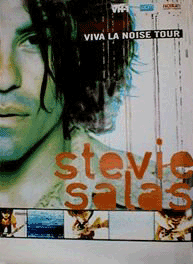 |
|
Viva La Noise tour poster |
SS: I know now that to stay in the game is what it’s all about. Look at George Clinton, Rod Stewart and the Stones. They keep the music out there. That’s what’s important! I remember I was gonna buy this Mercedes Benz from Rod Stewart and at the last minute he said, “I won’t sell you this car. Go buy a house.” He told me that a career is full of mountains and valleys and no one stays on top. But, you have to keep at it and I now know what he meant.
Did you have formal music education?
SS: None.
Have your musical tastes changed over the years?
SS: Not a lot. I still like the things I liked when I was a kid. I think most new bands are like fast food now. It’s not all their fault. Record companies do no development, so they stick shit derivative bands out there that sound like every other band. It’s hard to be original these days and have a career.
Do you feel you’ve achieved your music potential?
SS: Never. If I worked hard I could be the best. But I’m happy here with a balance. When I was young I worked so hard I forgot to enjoy life.
Tell us about your song writing process. Do you invest a lot in the creation of a song or are you more spontaneous?
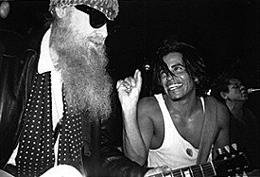 |
|
Stevie Salas (right) with Billy Gibbons |
SS: It’s all about the moment. I think about it in my mind and I then put it on a Walkman or jot it down on paper. Then I forget about it until it’s time to make a record. But, sometimes it’s on the spot.
When I made the Hardware CD with Buddy Miles and Bootsy Collins I had fifteen songs. I showed up in New York to work. But when we jammed the sound of the band changed all that. We wrote all but two of the songs on that CD on the spot.
When you’re on the road, do you do any of your own recordings with Pro Tools or other modern recording devices?
SS: No. I hate Pro Tools. I use it, but I miss tape. There are so many shit musicians now because of Pro Tools. Cut and paste this and that. I try to make recordings pretending that there are only twenty-four tracks and I make commitments the way I did with tape.
What’s currently in your iPod?
SS: Don’t have one.
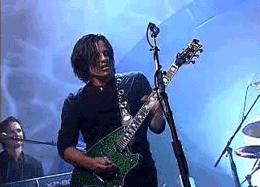 |
|
Stevie Salas |
It seems that the role of “lead guitar” has declined. Think we’ll see lead guitarists stepping out front more often in the future?
SS: It’s coming back big. I teach at a camp in Toronto in the summer for kids and they are getting into Zep 1 and 2 and Hendrix. They are the future. It’s all coming back to the ’70s!
Tell us about your latest project.
SS: My new studio CD will be called Stevie Salas: What It Was to Be, What It Is. I am off this week to record in Arizona with Dave Abbruzzese, so it should be done soon. I hope.
Related Links
Stevie Salas
All performance photos courtesy of Jim Steinfeldt
Jim Steinfeldt, an L.A.-based photographer, has worked with guitar and music legends such as Jeff Beck, Don Henley, Billy Gibbons, Sheryl Crow, Dee Dee Ramone and a long list of other music celebrities. Jim’s work was first published in 1985 in SPIN magazine. The same year, Rolling Stone published one of his photographs of Madonna, which he credits as a major boost to his career. Jim’s Elusive Studios rests in the canyons of Hollywood. In 1998, the music industry recognized his work by naming him Photographer of the Year at the Los Angeles Music Awards.